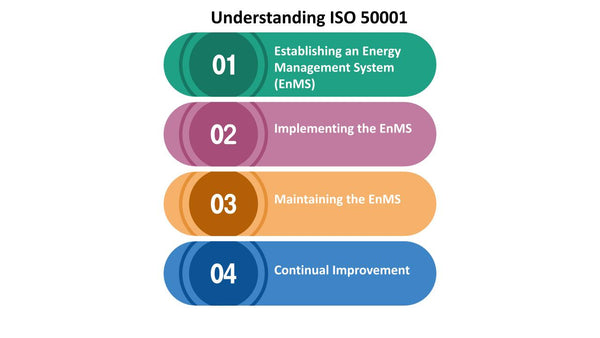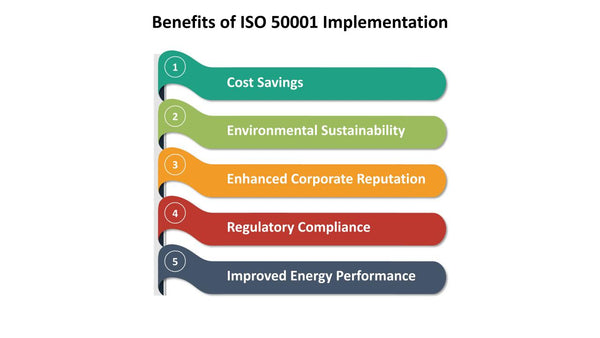Achieving Energy Efficiency Excellence with ISO 50001
In a world increasingly focused on sustainability and environmental responsibility, energy efficiency has emerged as a critical concern. Businesses and organizations worldwide are under pressure to reduce their carbon footprint, conserve resources, and lower operational costs. One essential tool in this endeavor is ISO 50001, an international standard for energy management systems. In this comprehensive guide, we will delve deep into ISO 50001, exploring its significance, key components, benefits, implementation process, case studies, and how it can be leveraged to drive energy efficiency excellence.

Understanding ISO 50001
ISO 50001 is a globally recognized standard developed by the International Organization for Standardization (ISO), first published in 2011, and widely adopted across industries. Its main purpose is to assist organizations in:
- Establishing an Energy Management System (EnMS): This involves creating a structured framework within the organization to manage energy resources efficiently.
- Implementing the EnMS: Once established, the EnMS must be put into action. This means incorporating energy management practices into the organization's daily operations.
- Maintaining the EnMS: ISO 50001 emphasizes the importance of sustaining the EnMS over time. This includes monitoring, measuring, and documenting energy usage and efficiency.
Key Components of ISO 50001
ISO 50001 provides a structured framework for organizations to manage their energy usage effectively. The standard consists of several key components:
- Energy Policy: An organization must establish a clear energy policy that aligns with its strategic objectives. This policy serves as a guiding document for energy management efforts.
- Energy Planning: Energy planning involves setting specific energy performance objectives and targets. Organizations must identify significant energy uses, consumption patterns, and relevant legal and other requirements.
- Implementation and Operation: This phase focuses on implementing actions to achieve the established objectives and targets. It includes designing and implementing energy-efficient projects and initiatives.
- Monitoring and Measurement: Regular monitoring and measurement of energy performance are essential to track progress. Data analysis helps identify areas for improvement.
- Management Review: Top management should regularly review the energy management system to ensure its continued effectiveness and alignment with organizational goals.
- Continual Improvement: ISO 50001 places a strong emphasis on continual improvement. Organizations should continually seek opportunities to enhance energy performance and efficiency.

Benefits of ISO 50001 Implementation
-
Cost Savings
One of the most tangible benefits of ISO 50001 implementation is cost savings. By optimizing energy use, organizations can significantly reduce energy expenses, leading to improved profitability. This reduction in energy costs is often one of the primary motivations for adopting the standard.
-
Environmental Sustainability
ISO 50001 aligns with global efforts to combat climate change and reduce greenhouse gas emissions. By using energy more efficiently, organizations can lower their carbon footprint and contribute to a more sustainable future.
-
Enhanced Corporate Reputation
Adopting ISO 50001 demonstrates a commitment to sustainability and responsible business practices. This can enhance an organization's reputation among customers, investors, and stakeholders, potentially leading to increased business opportunities.
-
Regulatory Compliance
Many countries and regions have introduced regulations and incentives related to energy efficiency. ISO 50001 can help organizations navigate these complex requirements and ensure compliance, reducing the risk of penalties or legal issues.
-
Improved Energy Performance
ISO 50001's focus on continual improvement means that organizations can continually enhance their energy performance over time. This can lead to long-term competitive advantages and resilience in a rapidly changing business landscape.
Implementing ISO 50001
Implementing ISO 50001 can be a complex process, but the benefits far outweigh the challenges. Here's a step-by-step guide to getting started:
-
Commitment from Top Management
The first crucial step is to secure a commitment from top management. Leadership support is essential for the successful implementation of ISO 50001.
-
Establish an Energy Team
Form a dedicated team responsible for overseeing the implementation process. This team should include energy experts and representatives from various departments.
-
Conduct an Energy Review
Identify the organization's significant energy uses and consumption patterns. Analyze existing energy data to establish a baseline for improvement.
-
Develop an Energy Policy
Create a clear and concise energy policy that aligns with the organization's strategic objectives. Ensure that all employees understand and support this policy.
-
Set Objectives and Targets
Establish specific energy performance objectives and targets. These should be measurable and time-bound, providing a clear roadmap for improvement.
-
Implement Energy Management Actions
Implement energy-efficient projects and initiatives to achieve the established objectives and targets. Ensure that resources are allocated appropriately.
-
Monitor and Measure
Regularly monitor and measure energy performance. Use data analysis to identify areas for improvement and track progress toward goals.
-
Evaluate Compliance
Ensure that the organization complies with all relevant legal and regulatory requirements related to energy efficiency.
-
Conduct Management Reviews
Top management should review the energy management system periodically to ensure its effectiveness and alignment with organizational goals.
-
Continual Improvement
Embrace a culture of continual improvement. Seek opportunities to enhance energy performance and efficiency continually.
Case Studies
To illustrate the real-world impact of ISO 50001, let's explore a couple of case studies:
-
Company A: Manufacturing Excellence
Company A, a manufacturing firm, implemented ISO 50001 and reduced its energy consumption by 15% within the first year. This not only led to substantial cost savings but also improved the company's competitive position in the market. Additionally, the firm received recognition for its environmental commitment, attracting new customers.
-
Hospital B: Sustainable Healthcare
Hospital B, a large healthcare facility, adopted ISO 50001 to reduce its energy costs and carbon emissions. Through better energy management practices, they were able to achieve a 20% reduction in energy consumption while maintaining high-quality patient care. This success resulted in reduced operational costs and enhanced community support.
Conclusion
ISO 50001 stands as a beacon of energy efficiency excellence, offering organizations a structured pathway to not only reduce operational costs but also champion environmental sustainability. By adhering to its key components, organizations can craft a comprehensive energy management system that drives continual improvement. The benefits, including cost savings, a reduced carbon footprint, enhanced reputation, and regulatory compliance, underscore the standard's significance in today's world. As businesses and societies grapple with the imperative of responsible energy usage, ISO 50001 remains a crucial tool for navigating the complex energy landscape.

